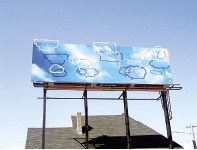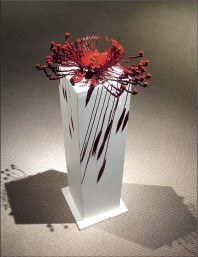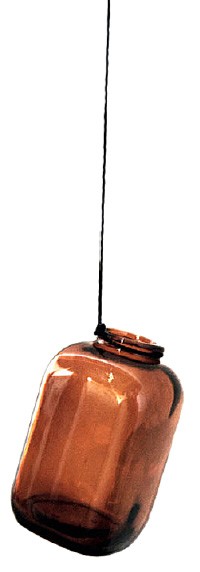Showing at L Ross Gallery are works by painter David Comstock and sculptor Bin Gippo, both masters of the fluid line and forms that feel weightless.
Circles loop across Comstock’s large canvases in Positive/Negative, and in Paradox, Gippo’s translucent alabaster sculptures appear to waft in midair. Like the mature work of Isamu Noguchi (the Japanese-American master sculptor with whom Gippo studied in New York), Gippo and Comstock go beyond seamless flow and integrate imperfection and duality into works expressive and complex enough to come alive on canvas and in stone.
A slender polished slab of steatite twists like a sea creature then fills out and arcs back like a graceful torso in Gippo’s From the Sea. The creature’s body is planted in raw stone. In Gippo’s most obviously figurative work, Getting Her Wings, a garden of crystals grows in the arm socket of a delicate and translucent body. Gippo’s torsos are not Venus de Milos forever armless and frozen in time. Her works express, instead, eons of evolution, the urge to expand to grow from sea creatures to humankind to angels-in-training.
Like Gippo, Comstock blurs the boundary between profane and sublime. The edges of Comstock’s circles are frayed; his loops are irregular. He gessoes and sews torn strips of canvas onto his paintings, and soft shades of taupe and beige, which look like earth dissolved in water, wash over many of his works.
A thick black line thrusts up in Positive/Negative 0401 and arcs into a series of irregular ovals that tangle at the top of the painting. A slender thread falls from the tangle to the bottom of the work. From the first rush to the last thread, Comstock is more interested in cycles of life than in idealized flow.

Cloudy Thoughts, by Greely Myatt, near the corner of Madison and Belvedere in Midtown
At L Ross Gallery through April 26th
To see one of the largest and most unusual artworks currently on view in Memphis, go to the corner of Madison and Belvedere and look up. You’ll see 14-by-48 feet of saturate blues (turquoises, thalos, and cadmiums) and wisps of white clouds covering the surface of Greely Myatt’s mixed-media billboard Cloudy Thoughts, one of the temporary projects commemorating the UrbanArt Commission’s 10th year. Metal outlines of speech and thought balloons throw shadows across the work.
Midtowners will tell you how they waited for days for workmen to spell out the idea or product being promoted on the billboard before they began thinking of things to fill the balloons for themselves. Immersed in Myatt’s deep-blue Rorschach, punctuated with clouds and phantom shadows, you can write your own script. Or, better yet, like Myatt, let the words go.
At Madison and Belvedere through the end of May

The Bloom of Your Words Touched Me, by Maysey Craddock
You’ll find several more of Myatt’s unique syntheses of speech balloons, wit, and wisdom at the Dixon Gallery and Gardens’ “2008 Memphis Flower Show: M3D On the Edge.” The exhibition features artworks paired with exquisite, interpretive floral arrangements by masters from around the country.
In addition to Myatt, the show includes works by some of the most original, sassy, accomplished 3D artists, including Maysey Craddock, Wayne Edge, Joyce Gingold, Terri Jones, Brian Russell, Allison Smith, Carroll Todd, and Ted Faiers.
Craddock’s typewriter keyboard, twisted back and painted deep red in The Bloom of Your Words Touched Me, evokes not only the power of words to endear, incite, or cut to the quick. Surrounded by beautiful floral arrangements, the work begins to resemble a wide-open exotic flower ready to soak up the sun or to snap shut like a Venus flytrap.
Leafless and branchless saplings crowd together in Carroll Todd’s constructed bronze sculpture, Lost in the Woods. An ebony ball is trapped between the slender stakes in a work that points to some starkly beautiful, fierce future in which forests are reduced to toothpicks and the earth reduced to a burned-out orb.
Terri Jones, best known for her elegant and minimal graphite drawings on vellum, contributes several works of conceptual art to “M3D.” In what could be an installation highlighting art as object, Jones shines a single light bulb above an unpadded wooden desk chair. One word, etched into a mirror and reflected on the wall above the chair, brings to mind One and Three Chairs, Joseph Kosuth’s 1970 exploration of the distinctions between reality and representation and between representation and language. Jones’ letters spell out the word “Move” in a work of art that takes us beyond duality to a Zen-like experience that oscillates our point of view between noun and verb, particle and wave, object and idea.
Nine accomplished artists and 52 of their most original, thought-provoking works, together at the same time in the same venue, make “M3D” a must-see show.
At the Dixon: “Memphis Flower Show” April 26th and 27th; “M3D” artworks up through June 1st
